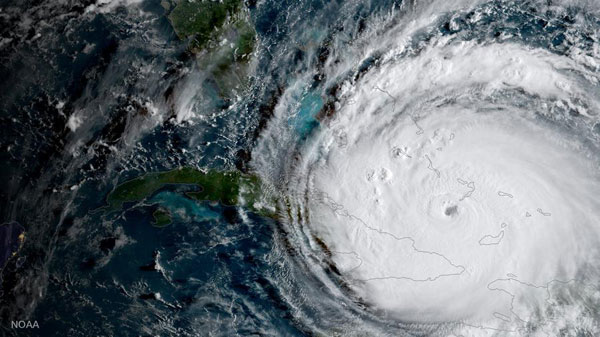Irma menaces Florida's Gulf Coast after striking Cuba
 |
|
Hurricane Irma is driving toward Florida passing the eastern end of Cuba in this NASA's GOES-16 satellite image taken at about 0800 EDT on September 8, 2017.[Photo/Agencies] |
Hurricane Irma pounded Cuba's northern coast on Saturday and barreled toward Florida's Gulf Coast as authorities scrambled to complete an unprecedented evacuation of millions of residents hours before the storm lashes the state.
Irma, one of the fiercest Atlantic storms in a century, was expected to rip through the Florida Keys archipelago on Sunday morning. It will make landfall on the Florida peninsula somewhere west of Miami on a track that would take it up the state's west coast, including Tampa, forecasters said.
Irma, which has killed at least 22 people in the Caribbean, was likely to inflict billions of dollars in damage in one of the most populous and fastest-growing states.
It could bring winds in excess of 100 miles per hour and a storm surge up to 15 feet (4.6 meters) high along the state's west coast, which is expected to trigger flooding.
The hurricane could rival any storm in Florida's history, with the storm surge generating flooding along the entire west coast, Governor Rick Scott said.
"Think about that, 15 feet is devastating and will cover your house," he said at a Saturday morning news conference.
Irma, located 195 miles (314 km/h) south of Miami on Saturday afternoon, still ranked as a Category 5 storm when it crashed into Cuba during the morning. It gradually weakened to a Category 3 storm as it bumped along the island's northern coastline, downing power lines, bending palm trees and sending waves crashing over sea walls.
Maximum sustained winds dipped to around 125 miles per hour (201 km per hour) by 11 am (1200 GMT) on Saturday, the US National Hurricane Center (NHC) said.
But Irma is expected to regain strength as it steams over warm waters south of Florida, according to the NHC. It was unclear if it would regain Category 4 or even Category 5 status, the highest ranking possible.
On Florida's west coast, a long line of people in Estero, north of Naples, lined up to enter an arena that officials converted into an evacuation shelter, one of hundreds that have opened up across the state.
To the east, Luise Campana Read was one of those who chose to ignore warnings and stay in her home. She said by phone she planned to ride out the storm in her beachfront condo in Fort Lauderdale, with her elderly mother and other family members.
"With a 97-year-old, there was no way I was going to have her sleep on a cot or a blow-up mattress" in a shelter, she said.
Later, some communities on Florida's east coast lifted evacuation orders when Irma's projected path edged west.
In Cuba, the destruction along the Caribbean country's north central coast was similar to that seen on other Caribbean islands over the last week as Irma plowed into Ciego de Avila province around midnight.
It was the first time the eye of a Category 5 storm had made landfall since 1932, state media said, and the island's Communist government ordered the evacuation of more than 1 million people, with most sheltering with family and friends.
"We are praying to God and the Virgin of Charity that nothing grave happens to the people of Florida, and in particular Miami," said Antonia Navarro, 56, an office worker in the northern Cuban port town of Nuevitas in Camaguey. "We have to pray a lot for our relatives who live there."























